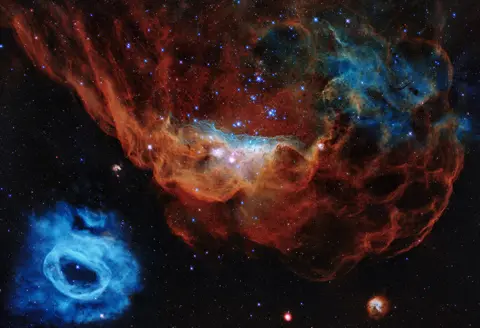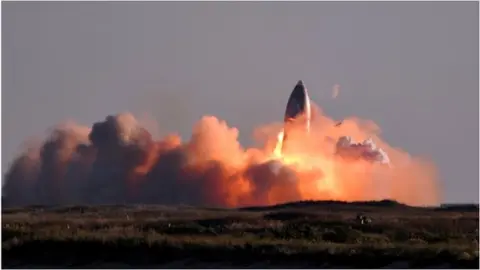Space images: The best of 2020
There was stunning cosmic imagery to feast on in 2020, from Hubble's 30th birthday image to footage of a daring sample grab on an asteroid. Here's our pick of the year's offerings.
Hubble's 'cosmic reef'
 NASA/ESA
NASA/ESAThe Hubble telescope, one of the most important scientific tools ever built, celebrated its 30th anniversary in April.
To mark the occasion, an amazing image was released showing a star-forming region close to our Milky Way galaxy.
In this magnificent Hubble portrait, the giant red nebula (NGC 2014) and its smaller blue neighbour (NGC 2020) reside in the Large Magellanic Cloud, a satellite galaxy of the Milky Way located 163,000 light years away.
Nebulas are vast interstellar clouds of dust and gas where star formation can take place.
At the heart of NGC 2014 is a clutch of bright stars, which are each 10 to 20 times more massive than our Sun.
The image was nicknamed the "cosmic reef", because astronomers thought the nebulas resembled an undersea world.
A BBC Horizon documentary, broadcast to coincide with the anniversary, showcased stunning 3D visualisations of iconic Hubble images - such as the Pillars of Creation, part of the Eagle Nebula.
Asteroid grab
This year, Nasa's Osiris-Rex performed a daring "touch-and-go" manoeuvre with the asteroid Bennu, in order to collect samples of rock and soil for delivery to Earth.
Asteroids like Bennu are primitive relics from the dawn of the Solar System. They are the free-roaming building blocks of planets, and offer a window into how worlds like the Earth came into being.
In order to collect samples, Osiris-Rex used a long boom with a ring-shaped collection chamber on the end. The spacecraft descended towards Bennu's surface, delivering a squirt of nitrogen when the boom made contact with the asteroid.
This was so that the gas would stir up Bennu's surface, allowing fragments of the asteroid to float into the collection chamber.
The strategy seems to have worked, as seen in the sequence of images above.
Meanwhile, on 5 December, a Japanese mission to collect samples from a different asteroid returned to Earth with its precious cache. The Hayabusa-2 spacecraft released its sample return capsule, which parachuted down safely in the Australian desert.
The samples will be analysed at a curation facility in Sagamihara City, Japan.
Close-up with the Sun
January saw the release of pictures taken by the Daniel K Inouye Solar Telescope (DKIST) on Hawaii that showed the Sun's surface in unprecedented detail.
The images show cell-like structures that are roughly the size of the US state of Texas. They are masses of hot, excited gas, or plasma.
The bright areas denote where this material is rising; the dark lanes in-between are where cooler plasma is sinking.
DKIST is a brand new facility on Haleakalā, a 3,000m-high volcano on the Hawaiian island of Maui.
Scientists want to use it to uncover fresh insights into the dynamic behaviour of our parent star, in the hope that they can better forecast its energetic outbursts.
These colossal eruptions of charged particles can damage Earth-orbiting satellites, harm astronauts, and even to knock out electrical grids.
Jupiter fly-past
Allow Google YouTube content?
Launched in 2011, Nasa's Juno spacecraft continues to send back stunning images from the Solar System's biggest planet - Jupiter.
The probe captured imagery of the gas giant's swirling cloud decks as it performed its 27th close flyby of the world on 2 June.
Citizen scientist Kevin M Gill then transformed the data into a video, which combines 41 still images taken during Juno's close pass.
The stills were digitally projected onto a sphere, with a virtual "camera" providing views of Jupiter from different angles.
Among other things, the footage provides amazing views of Jupiter's most noticeable feature, the giant red spot - which is actually a gigantic ongoing storm.
Starship test
 SpaceX
SpaceXLooking a little like a rocket ship from the golden age of science fiction, Elon Musk's Starship vehicle will - in due course, he hopes - transport humans to the Red Planet.
In December, SpaceX tested the first complete prototype of the vehicle, sending it on a 12.5km flight straight up from its pad at the company's Boca Chica facility in South Texas.
 SpaceX
SpaceXWe're cheating a little with its inclusion here, since the images aren't from space, as such. But we might see it there one day, in the not-too-distant future.
The test flight showcased some of the spacecraft's unique features, including its methane-burning Raptor engines and a flight trajectory which includes a belly-facing descent to Earth followed by a flip back to the vertical just before landing.
 Reuters
ReutersIt was at this stage of the test that the Starship prototype, named SN8, approached the pad a little too fast and hard, causing what Musk describes as a RUD - rapid unscheduled disassembly. A crash, in other words.
But the flight will have given SpaceX vast amounts of engineering data to chew on, helping them improve the vehicle. And the next prototype - SN9 - is waiting for its turn on the launch pad.
Follow Paul on Twitter
